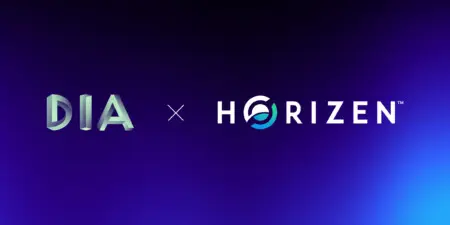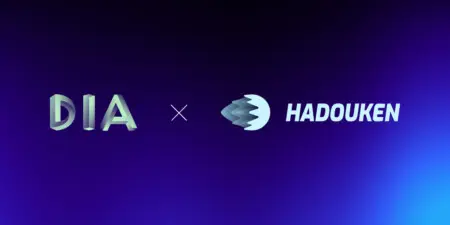DIA Price Oracles Enable Diverse Collateral Support for Bit Protocol on Base
DIA oracles now provide verifiable price feeds for nine Base ecosystem assets, enabling BitUSD to safely accept collateral from DeFi protocols, meme coins, and AI agent tokens

Oracle Infrastructure for Omni-Chain Stablecoins
Collateralized debt position protocols depend on oracle reliability. Inaccurate pricing doesn’t just affect individual positions, it creates systemic risk that can cascade through the entire protocol, triggering mass liquidations and threatening the stablecoin’s peg.
DIA now provides price feeds for Bit Protocol’s collateral types on Base, enabling the protocol to safely support diverse assets ranging from established DeFi protocols to emerging meme coins and AI agent tokens. The integration delivers verifiable pricing infrastructure for BitUSD, an overcollateralized omni-chain stablecoin operating across multiple blockchain networks.
The CDP Challenge: Diverse Collateral, Critical Pricing
Bit Protocol takes a comprehensive approach to collateral acceptance. Rather than limiting deposits to a few blue-chip assets, the platform enables users to mint $bitUSD against a wide range of crypto assets: liquid staking tokens, real-world assets, native blockchain tokens, Treasury bills, AI agent tokens, and community tokens.
This diversity creates capital efficiency, users can unlock liquidity from various holdings without selling. But it also creates an oracle challenge. Each collateral type requires accurate, timely pricing. A DeFi protocol token, a meme coin, and an AI agent token each present different data sourcing and validation requirements.
The Bit Protocol team has written extensively about this challenge, publishing detailed analysis on how “oracle lag”, delays in price feed updates, represents the silent killer of stablecoins. Their research emphasizes that stablecoin depegs rarely begin with dramatic collapses. Instead, they start with subtle delays in oracle feeds that prevent protocols from responding to market movements in time.
DIA's Role: Verifiable Feeds for Base Ecosystem Assets
DIA delivers price feeds for nine Base ecosystem collateral types currently supported by Bit Protocol:
DeFi Infrastructure:
- AERO – Aerodrome Finance, the leading decentralized exchange on Base with over $500M in liquidity
- cbETH:
- ETH:
Community & Meme Tokens:
- BRETT – Major Base ecosystem community token with governance features
- DEGEN – Farcaster community token operating its own Layer 3 chain on Base
- TOSHI – Base ecosystem meme token
- CLANKER – Community token on Base
AI Agent Tokens:
Ecosystem Tokens:
Each feed pulls pricing data from primary sources and publishes to Base through DIA’s oracle infrastructure. The rollup-based architecture makes every oracle computation verifiable on-chain, creating an auditable trail from data source to smart contract.
Building stablecoins people can trust means partnering with those who value accuracy and transparency. With DIA, we can support collateral from all parts of the Base ecosystem, including DeFi tokens, community coins, and the latest AI assets, all without sacrificing reliability. For BitUSD, real-time and verifiable pricing keeps our peg strong, our collateral safe, and the user experience smooth no matter how fast the market moves. That’s how stablecoins can power the next wave of on-chain innovation.Alejandro LosaCEO of BitUSD
Why Base Ecosystem Diversity Matters
Base has emerged as a hub for crypto innovation beyond traditional DeFi. The network hosts thriving communities building everything from decentralized exchanges to social platforms to AI agent frameworks. This creates genuine economic activity across diverse asset types.
For CDP protocols, this diversity presents opportunity and challenge. Accepting varied collateral increases capital efficiency and user options. But it requires oracle infrastructure capable of handling assets with different liquidity profiles, trading venues, and data availability characteristics.
DIA’s approach addresses this through comprehensive data sourcing across 100+ primary sources. The same oracle infrastructure providing price feeds for established DeFi protocols can also deliver reliable pricing for emerging asset classes, all with consistent verification standards.
Technical Implementation
The integration operates through several components:
Primary Source Data Collection: DIA connects directly to trading venues and liquidity sources for each asset type. This approach eliminates reliance on aggregated data and provides the most current market state.
On-Chain Data Publishing: Price feeds update on Base at intervals calibrated to each asset’s market characteristics. The oracle contracts maintain current pricing while managing gas costs appropriately for network conditions.
Verifiable Computation: DIA’s rollup infrastructure processes all oracle calculations on-chain. This makes every price point auditable, not just the final published value, but the computation itself.
Cross-Chain Consistency: Bit Protocol’s omni-chain architecture enables $bitUSD to exist natively across multiple networks. DIA’s oracle infrastructure spans the same networks, providing consistent pricing standards as the protocol expands.
The Oracle Lag Prevention Model
Bit Protocol’s analysis of oracle lag highlights why infrastructure choices matter for CDP protocols. When prices move rapidly, protocols need current data to maintain appropriate collateralization ratios and trigger liquidations before positions become undercollateralized.
Traditional approaches create lag through several mechanisms: reliance on aggregated data that’s already delayed when received, off-chain computation that must be submitted on-chain, and update intervals optimized for cost rather than accuracy.
DIA’s architecture addresses these through on-chain computation that makes calculations transparent and verifiable, direct primary source connections that eliminate aggregation delay, and customizable update frequencies that protocols can calibrate to their risk models.
For Bit Protocol’s 110%+ minimum collateralization requirement, this means the protocol can maintain safety margins even during volatile markets. Accurate, timely pricing enables the automated insurance pools to function as designed, protecting the peg without requiring excessive overcollateralization that would reduce capital efficiency.








